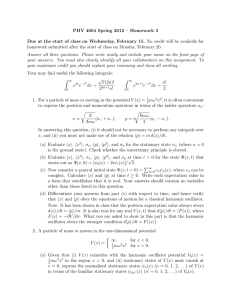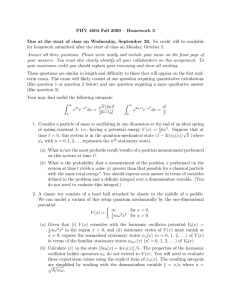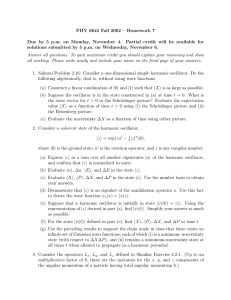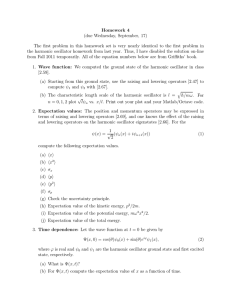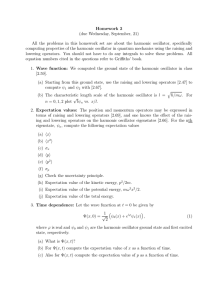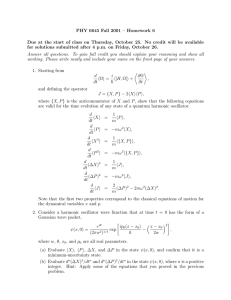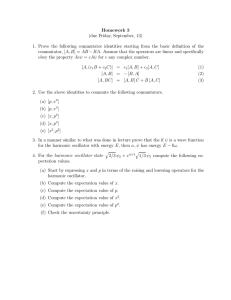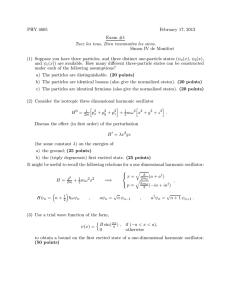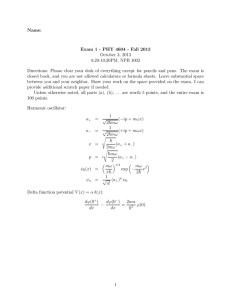PHY 4604 Fall 2008 – Homework 3
advertisement
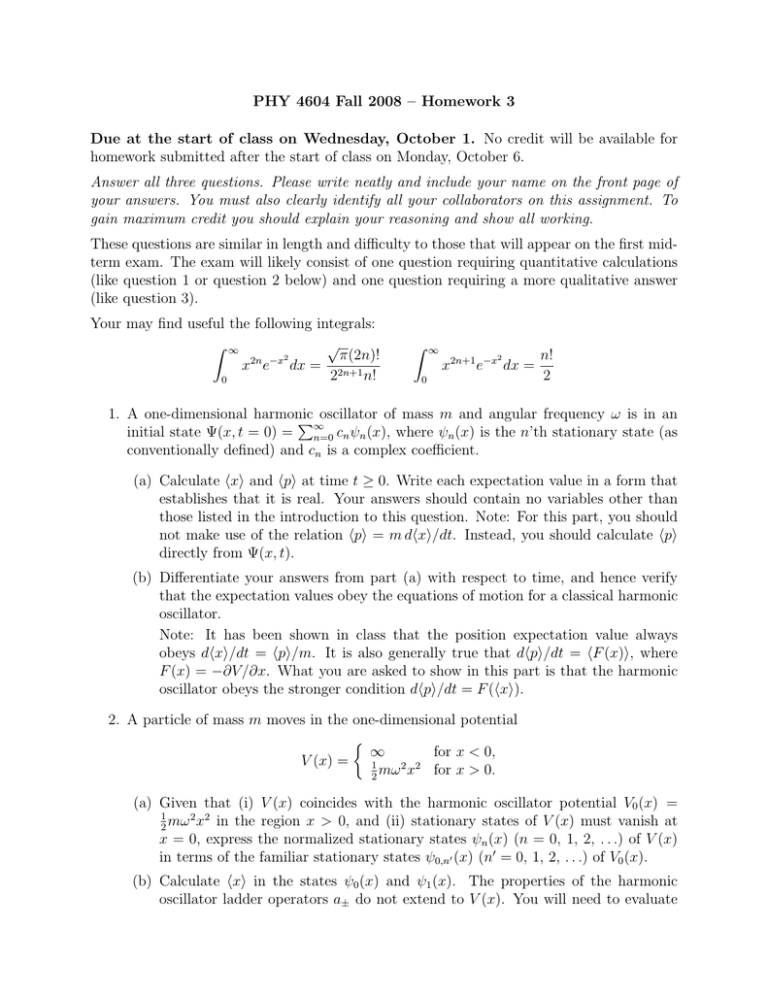
PHY 4604 Fall 2008 – Homework 3 Due at the start of class on Wednesday, October 1. No credit will be available for homework submitted after the start of class on Monday, October 6. Answer all three questions. Please write neatly and include your name on the front page of your answers. You must also clearly identify all your collaborators on this assignment. To gain maximum credit you should explain your reasoning and show all working. These questions are similar in length and difficulty to those that will appear on the first midterm exam. The exam will likely consist of one question requiring quantitative calculations (like question 1 or question 2 below) and one question requiring a more qualitative answer (like question 3). Your may find useful the following integrals: √ Z ∞ π(2n)! 2n −x2 x e dx = 2n+1 2 n! 0 Z 0 ∞ 2 x2n+1 e−x dx = n! 2 1. A one-dimensional harmonic P∞oscillator of mass m and angular frequency ω is in an initial state Ψ(x, t = 0) = n=0 cn ψn (x), where ψn (x) is the n’th stationary state (as conventionally defined) and cn is a complex coefficient. (a) Calculate hxi and hpi at time t ≥ 0. Write each expectation value in a form that establishes that it is real. Your answers should contain no variables other than those listed in the introduction to this question. Note: For this part, you should not make use of the relation hpi = m dhxi/dt. Instead, you should calculate hpi directly from Ψ(x, t). (b) Differentiate your answers from part (a) with respect to time, and hence verify that the expectation values obey the equations of motion for a classical harmonic oscillator. Note: It has been shown in class that the position expectation value always obeys dhxi/dt = hpi/m. It is also generally true that dhpi/dt = hF (x)i, where F (x) = −∂V /∂x. What you are asked to show in this part is that the harmonic oscillator obeys the stronger condition dhpi/dt = F (hxi). 2. A particle of mass m moves in the one-dimensional potential ∞ for x < 0, V (x) = 1 2 2 mω x for x > 0. 2 (a) Given that (i) V (x) coincides with the harmonic oscillator potential V0 (x) = 1 mω 2 x2 in the region x > 0, and (ii) stationary states of V (x) must vanish at 2 x = 0, express the normalized stationary states ψn (x) (n = 0, 1, 2, . . .) of V (x) in terms of the familiar stationary states ψ0,n0 (x) (n0 = 0, 1, 2, . . .) of V0 (x). (b) Calculate hxi in the states ψ0 (x) and ψ1 (x). The properties of the harmonic oscillator ladder operators a± do not extend to V (x). You will need to evaluate these expectation values using the explicit form of ψn (x). The resulting integrals are simplified by working with the dimensionless variable ξ = x/a where a = p ~/mω. 3. Consider a particle of mass m moving in one dimension under the influence of a doublestep potential x < −a, −V0 0 −a < x < a, V (x) = x > a, V0 with V0 = π 2 ~2 /ma2 . (a) List the range(s) of energies E (if any) within which you expect stationary states to be (i) forbidden; (ii) allowed at discrete energies only; (iii) allowed at all energies within the range; (iv) doubly degenerate. (b) List the range(s) of energies E (if any) within which you expect to be able to construct stationary states having a nonzero probability current. The remainder of this problem concerns a particular stationary state of this problem: one of energy E = V0 /2, having a wave function ψ(x). Answer the questions below using qualitative arguments wherever possible. It should not be necessary for you to obtain a full quantitative solution for ψ(x). (c) Write down the form of ψ(x) in the region x > a. Express the wavelength or exponential decay length (whichever is appropriate) of ψ(x) in this region as a multiple of a. (The exponential decay length is l in e−x/l .) Show that the probability current vanishes in this region. (d) Write down the form of ψ(x) in the region −a < x < a. Express the wavelength or exponential decay length of ψ(x) in this region as a multiple of a. What is the probability current in this region? (e) Write down the form of ψ(x) in the region x < −a. Express the wavelength or exponential decay length of ψ(x) in this region as a multiple of a. What is the probability current in this region? (f) Based on the analogy with classical mechanics, explain whether you expect the maximum amplitude of ψ(x) in the region x < −a to be greater than, less than, or equal to the maximum amplitude of ψ(x) in the region −a < x < a. (g) Sketch a graph of the probability density |ψ(x)|2 as a function of x. The horizontal axis should range from x = −3a to x = 3a, and should have the points x = −a and x = a explicitly labeled. You should be careful to represent correctly as many features of the graph as possible (based on the information derived in the previous parts of the problem).
